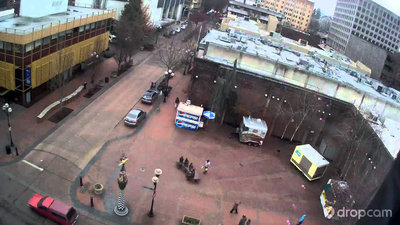
What is there about Kesey Square that needs fixing? It depends on whom you ask. Even the little bird sitting on Ken Kesey’s shoulder knows that there has long been a desire by those concerned with the need to improve the pedestrian and shopping experience downtown to fill up the space with a new building. Theirs is a defensive point of view. They see the square’s present clientele as a public nuisance that seriously detracts from their shopping mall ideal. Filling in the square would move that problem to somewhere else.
Those who value and would improve the publicness of our downtown tend to see the situation differently. They worry about losing any of our present inadequate supply of downtown park and open space. The newest projects downtown, the large Capstone and LCC housing projects, certainly didn’t provide any. At Capstone, the sidewalks are so narrow that in some places pedestrians are pressed up against adjoining streets. LCC’s orientation, too, is completely inward.
For them, any serious downtown park and open space planning is hovering in suspended animation. They see funding for the existing Parks Blocks Master Plan and the reclaiming of the butterfly parking garage’s North Park Block site as at best a distant hope. They perceive the present attitude to public space downtown as fearful, antisocial and wall-it-in medieval, and so their attitude is reflective of Ken Kesey’s “Never give a inch.”
But the times for both, “they are a changing.” A downtown population of 2,000 is about to become 4,000, full of fledgling young adults eager to enjoy and mark their new home territory. As they begin to spread out, more youth-supporting public spaces will be needed, not less. The times “they are a calling” for the changing of attitudes toward downtown open space from defense to offense.
And Kesey Square will need to be designed for this new role. Not redesigned, because the present space is really just a cobbling together of serial leftovers from the mall era. It was never actually designed to be a successful public place and as such has some serious flaws.
More than anything else, it’s the blank brick walls of the adjoining buildings that make up the square’s two dead sides that are holding it back. In any other square in any other city in the world, those sides would be alive with penetrations and connections between the square’s outdoor spaces and the activities and services of the interiors beyond.
At the ground level those commercial activities would spill out into the square. People would be sitting at tables under glass and under colored canvas where there is room enough, unlike the sides of Eugene’s too narrow sidewalks. They would be having continental breakfasts or an afternoon drink, busy attending to the mating rituals of the weekend dance, listening to a concert or performance, or just sitting under cover, having intimate and profound conversations late into the night (just like in a real city).
And windows and balconies on the upper floors would be alive with light and the watchful eyes of people on the space below.
Fixing the square will mean moving Peter Helzer’s fine Kesey sculpture out of the center of the space toward the intersection to create a central area for dancing, performances and gatherings. The space will need to be fully teched-up for sound and lighting and wi-fi.
And the food carts will be able to move back to serving foot traffic along Willamette Street or over to South Park Street to support fair weather lunches in the South Park Block and the Saturday Market.
Playing open space offense downtown means designing it for people, not against them. Conceiving of the square as actively including the two buildings that create it is the necessary conceptual transformation. It opens up new business opportunities for the lucky building owners. But even more, the expanded square idea opens up the possibility of turning an underperforming public open space into a potentially successful public/private partnership and civic asset. Such fresh thinking might even become addictive.
And it’s not just the younger crowd that will benefit. Some will remember two-time presidential candidate Adlai Stevenson’s response when asked what he would do in retirement. He replied, “I’ll sit on the terrace with a glass of red wine and watch the young people dance.”